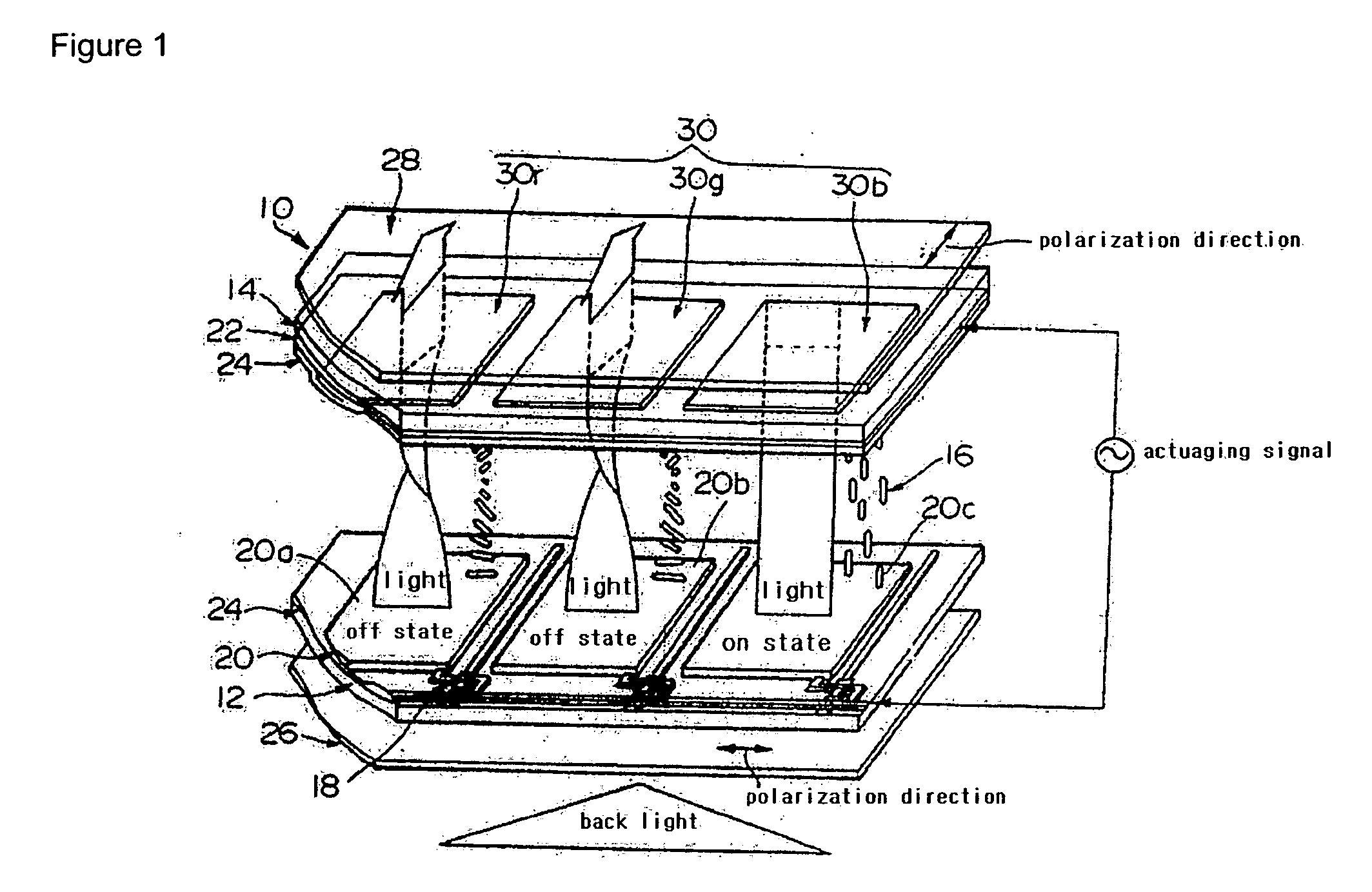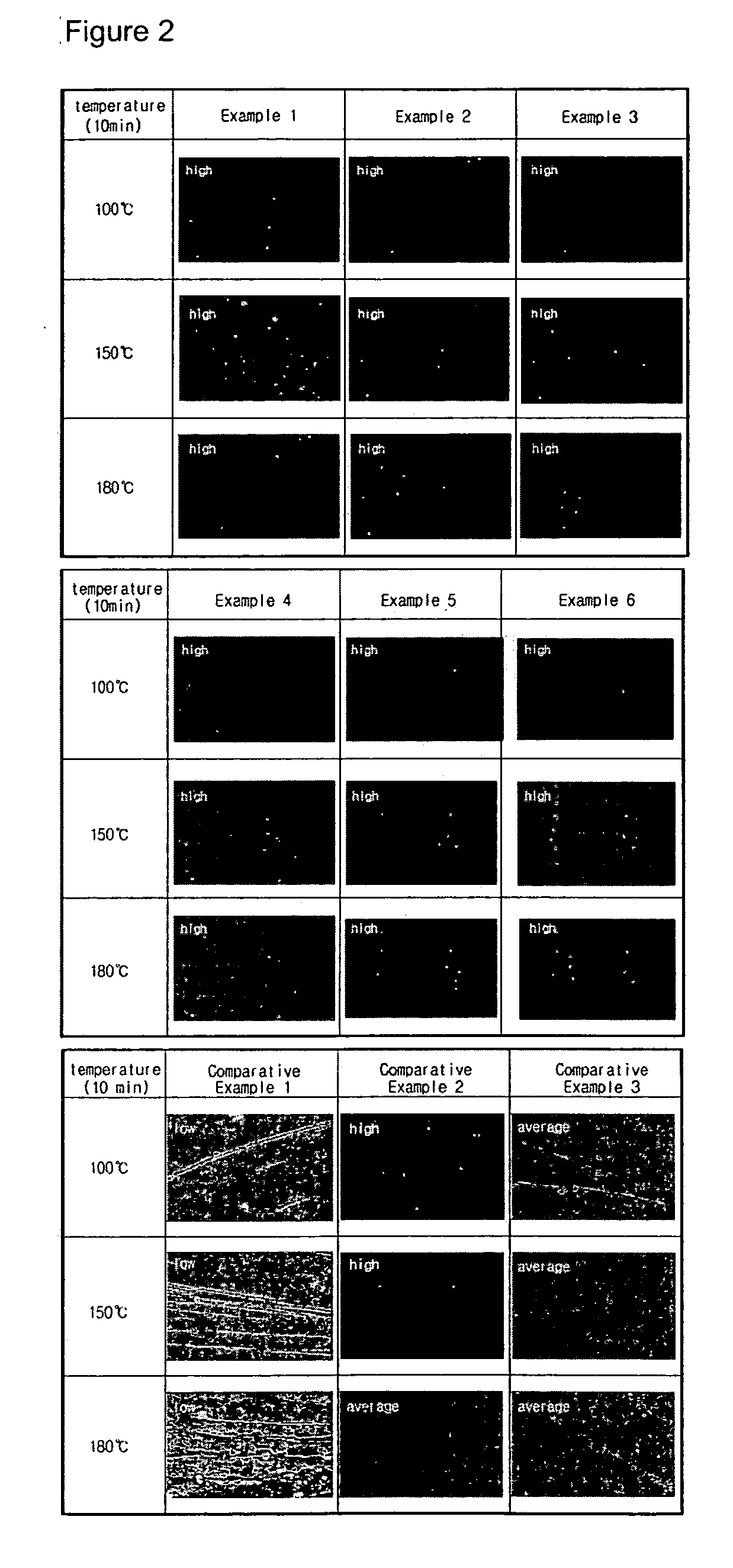Alignment film for LCD using photoreactive polymer and LCD comprising the same
- Summary
- Abstract
- Description
- Claims
- Application Information
AI Technical Summary
Benefits of technology
Problems solved by technology
Method used
Image
Examples
synthesis example 1
[0091] 1-(1) Synthesis of Monomer
Synthesis of 5-norbornene-2-methanol
[0092] After DCPD (dicyclopentadiene, Aldrich, 397 g, 3 mol) and allyl alcohol (Aldrich, 331 g, and 5.7 mol) were put into a 2 L high pressure reactor, temperature was increased to 210° C. After a reaction was conducted for 1 hour while agitating at 300 rpm, reactants were cooled and moved to a distillator. Distillation was repeatedly conducted under reduced pressure of 1 torr using a vacuum pump twice to obtain a product at 56° C. (yield: 52%)
[0093]1H-NMR (300 MHz, CDCl3): δ 6.17˜5.91 (m, 2H), 3.71˜3.19 (m, 2H), 2.91˜2.75 (m, 2H), 2.38 (m, 1H), 1.83 (m, 1H), 1.60˜1.12 (m, 2H), 0.52 (m, 1H)
Synthesis of 5-norbornene-2-methylcinnamate
[0094] After 5-norbornene-2-methanol (15 g, 0.121 mol), which was synthesized as described above, triethylamine (Aldrich, 61.2 g, 0.605 mol), and 20 ml of THF were put into a 250 ml two-neck flask, agitation was conducted in an ice-water bath at 0° C. Cinnamoyl chloride (22.1 g, 0.1...
synthesis example 2
[0099] 2-(1) Synthesis of Monomer
Synthesis of 4-hydroxy methylcinnamate
[0100] After 4-hydroxy cinnamic acid (Aldrich, 20 g, 0.122 mol) was dissolved in 120 ml of methanol, 2 ml of a sulfuric acid was added thereto. After a reflux was conducted at 65° C. for 5 hours, reactants were cooled and pressure was reduced to remove excess methanol. A red solid was obtained. It was extracted with a great quantity of ethyl acetate, washed with NaHCO3 and H2O, dried with anhydrous MgSO4, and filtered, and the solvent was removed using a rotary evaporator, thereby a red solid product was obtained. Yield: 20.63 g (95%)
[0101]1H-NMR (400 MHz, acetone d6): δ 7.58˜7.62s (d, 1H), 7.53˜7.55(dd, 2H), 6.88˜6.91(dd, 2H), 6.32˜6.36 (d, 1H), 3.70(s, 3H)
Synthesis of (methylcinnamate)-5-norbornene-2-carboxylate
[0102] A norbornene carboxyl acid (Aldrich, 11 g, 79.64 mmol), 4-hydroxy methylcinnamate (12.9 g, 72.4 mmol), which was synthesized as described above, EDC [1-(3-Dimethylaminopropyl)-3-ethylcarbodii...
synthesis example 3
[0107] 3-(1) Synthesis of Monomer
Synthesis of 6-(4-oxy methyl cinnamate)hexanol
[0108] 4-hydroxy methyl cinnamate (8 g, 44.9 mmol), synthesized as described above, NaOCH3 (Aldrich, 2.4 g, 44.9 mmol), and NaI (270 mg, catalytic quantity) were put into a 250 ml two-neck flask, and then dissolved in 100 ml dimethylacetamide. After agitation was conducted for 1 hour, chlorohexanol (Aldrich, 6 ml, 44.9 mmol) was added thereto, and a reflux was conducted at 100° C. for 2 days. Once the reaction was completed, it was cooled to room temperature, and the solvent was removed. Subsequently, the resulting solid was dissolved in an excessive amount of methanol to remove an undissolved solid portion, and pressure was reduced to remove the solvent; thereby 8.4 g of a white solid product was obtained (yield: 67.2%).
[0109]1H-NMR (400 MHz, CDCl3): δ 7.64˜7.68 (d, 1H), 7.48˜7.49 (dd, 2H), 6.89˜6.91 (dd, 2H), 6.30˜6.34 (d, 1H), 3.98˜4.02 (t, 2H), 3.81 (s, 3H), 3.67˜3.70 (t, 2H), 1.46˜1.84 (m, 8H)
Syn...
PUM
| Property | Measurement | Unit |
|---|---|---|
| Time | aaaaa | aaaaa |
| Time | aaaaa | aaaaa |
| Time | aaaaa | aaaaa |
Abstract
Description
Claims
Application Information
 Login to View More
Login to View More - R&D
- Intellectual Property
- Life Sciences
- Materials
- Tech Scout
- Unparalleled Data Quality
- Higher Quality Content
- 60% Fewer Hallucinations
Browse by: Latest US Patents, China's latest patents, Technical Efficacy Thesaurus, Application Domain, Technology Topic, Popular Technical Reports.
© 2025 PatSnap. All rights reserved.Legal|Privacy policy|Modern Slavery Act Transparency Statement|Sitemap|About US| Contact US: help@patsnap.com



